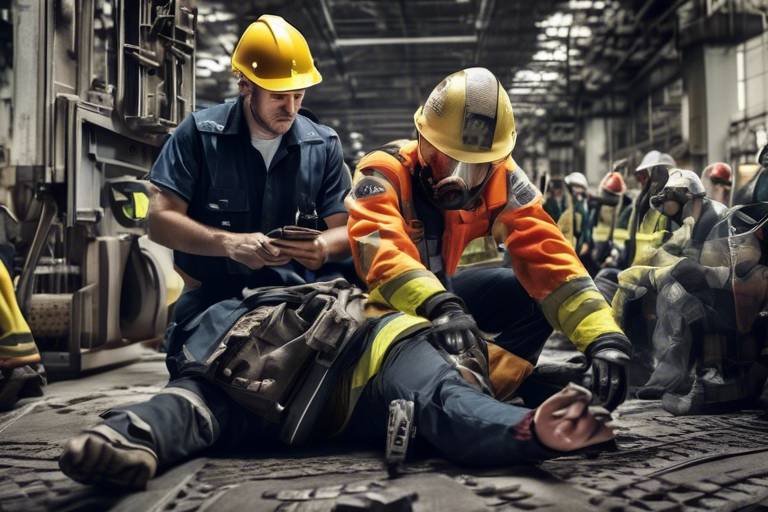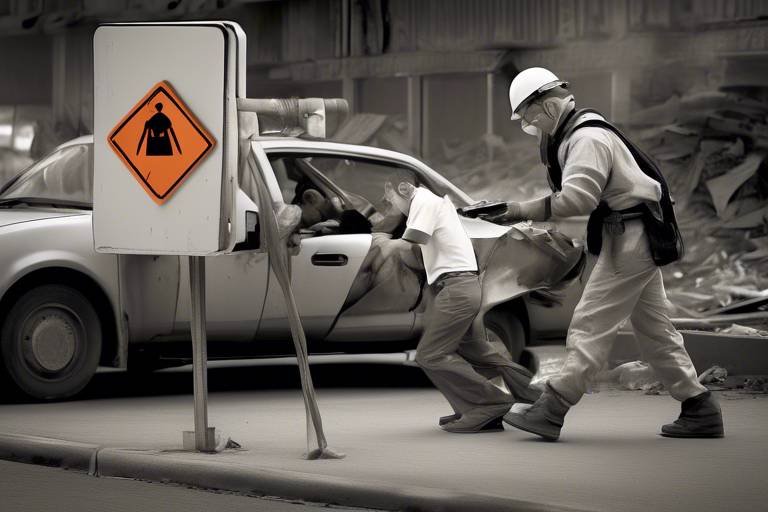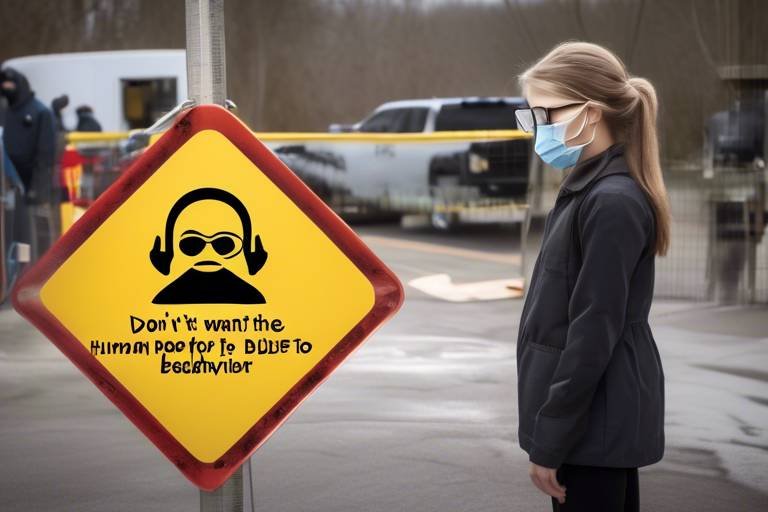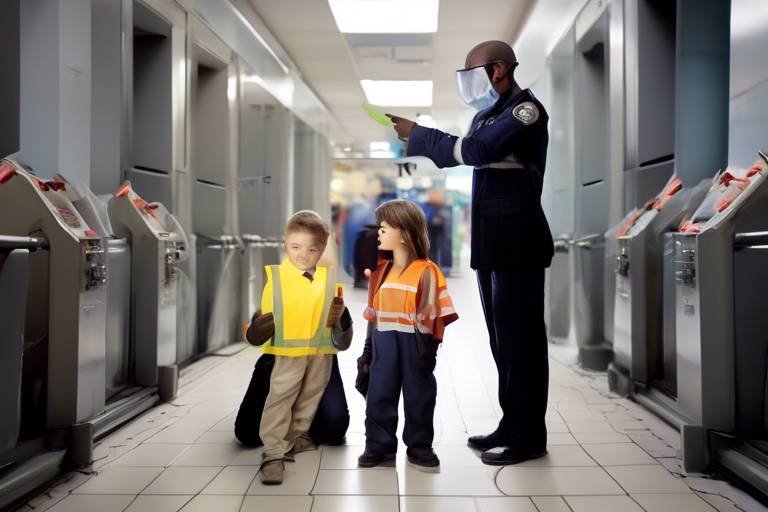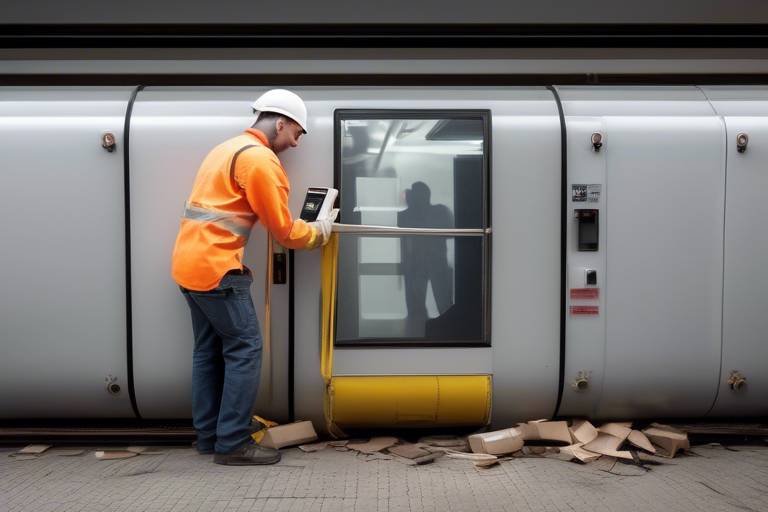Decoding the Intricacies of Safety with Human Behavior
In our rapidly changing world, the intersection of human behavior and safety has never been more critical. Whether in bustling workplaces, crowded public spaces, or even at home, the way we perceive and respond to safety can significantly influence our well-being. Have you ever wondered why some people seem to take risks without a second thought, while others are overly cautious? This article dives deep into the complex relationship between our psychological makeup and safety practices, unraveling the intricate threads that bind them together.
At the heart of this exploration lies the understanding that safety is not merely a set of rules or protocols; it's a reflection of our psychological state. Our brains are wired to assess risks constantly, but this process is often clouded by cognitive biases and emotional responses. For instance, when faced with a potential hazard, some individuals may underestimate the danger due to optimism bias, believing that "it won't happen to me." On the flip side, others may be paralyzed by fear, overestimating risks and avoiding situations that are, in reality, quite safe. This dichotomy highlights the importance of understanding how our minds work when it comes to safety.
Moreover, the implications of these psychological factors extend beyond individual behavior. In organizational settings, the collective mindset can shape the safety culture. When employees perceive safety as a shared value, they are more likely to engage in safe practices and encourage their peers to do the same. This creates a ripple effect, fostering an environment where safety is prioritized and ingrained in everyday operations.
As we navigate this intricate landscape, it's essential to recognize that enhancing safety is not just about implementing strict regulations. It's about creating a holistic approach that considers the human element. By understanding the psychological underpinnings of risk perception and behavior, we can develop strategies that resonate with individuals on a deeper level, ultimately leading to a safer world for everyone.
Understanding how individuals perceive risk is crucial for developing effective safety protocols. This section delves into the cognitive biases and emotional factors that shape our understanding of safety and danger.
Implementing behavioral safety practices can significantly reduce accidents. This subheading discusses the strategies organizations can adopt to promote safe behaviors and create a culture of safety among employees.
Training and education are vital in shaping safe behaviors. This section highlights the importance of ongoing training programs and how they can enhance safety awareness and compliance among individuals.
Clear communication is essential in safety training. This subheading explores various communication strategies that can improve understanding and retention of safety information among employees.
Feedback mechanisms play a crucial role in reinforcing safe behaviors. This section discusses how providing constructive feedback can motivate individuals to adhere to safety protocols consistently.
Social norms significantly impact behavior in safety contexts. This subheading examines how peer influence and group dynamics can either promote or hinder safe practices in various settings.
Advancements in technology are transforming safety practices. This section discusses the tools and innovations that can enhance safety monitoring and promote safer behaviors in workplaces and public areas.
Wearable safety devices are becoming increasingly popular. This subheading explores how these technologies can provide real-time data and alerts, helping individuals make safer decisions in hazardous environments.
Data analytics plays a crucial role in safety management. This section discusses how analyzing safety data can identify trends, predict hazards, and improve overall safety strategies within organizations.
- What is the importance of understanding human behavior in safety? Understanding human behavior helps in creating effective safety protocols that resonate with individuals, leading to improved compliance and safer environments.
- How can organizations promote a culture of safety? Organizations can promote a safety culture by implementing ongoing training, encouraging open communication, and recognizing safe behaviors among employees.
- What role does technology play in enhancing safety? Technology provides tools for monitoring safety practices, real-time data, and analytics that can help predict and mitigate risks effectively.

The Psychology of Risk Perception
Understanding how individuals perceive risk is crucial for developing effective safety protocols. Our brains are wired to interpret danger, but the way we assess risks can be influenced by a myriad of factors, including cognitive biases and emotional responses. For instance, have you ever noticed how some people fear flying more than driving, despite statistics showing that air travel is significantly safer? This discrepancy often stems from our emotional reactions rather than the actual level of risk involved.
Cognitive biases play a pivotal role in shaping our perception of risk. These biases can lead us to overestimate or underestimate dangers based on personal experiences or societal influences. For example, the availability heuristic suggests that if something can easily be recalled—like a recent news story about a plane crash—we are likely to perceive it as more common and dangerous than it truly is. This can skew our judgment and lead to irrational fears.
Moreover, our emotional state can amplify or diminish our perception of risk. When we feel anxious or stressed, we may view situations as more perilous than they are. Conversely, in a relaxed state, we might underestimate the dangers around us. This emotional rollercoaster can significantly impact our decision-making processes, especially in high-stakes environments like workplaces or public spaces.
To further illustrate the complexities of risk perception, consider the following factors:
- Personal Experience: Individual experiences can skew risk perception. Someone who has been in a car accident may have a heightened fear of driving.
- Social Influence: The opinions and behaviors of those around us can shape our perceptions. If our friends express fear about a certain activity, we might adopt that fear.
- Media Representation: The media often sensationalizes certain risks, leading to inflated perceptions. This can cause individuals to avoid activities that are statistically safe.
Understanding these psychological aspects is essential for creating effective safety protocols. By recognizing the biases and emotional triggers that influence our perceptions, organizations can tailor their safety messages to resonate more effectively with their employees. For instance, using relatable stories or real-life examples can help individuals connect with the information on a personal level, making them more likely to adhere to safety practices.
In conclusion, the psychology of risk perception is a complex interplay of cognitive and emotional factors. By addressing these elements, we can foster a better understanding of safety and encourage more responsible behaviors in various environments. As we move forward, it's vital to incorporate these insights into our safety training and communication strategies, ensuring that individuals not only understand the risks but also feel empowered to act safely.
- What is risk perception? Risk perception refers to the subjective judgment individuals make regarding the severity and probability of a risk.
- How do cognitive biases affect safety? Cognitive biases can distort our understanding of risks, leading to either overestimation or underestimation of danger.
- Why is emotional state important in risk perception? Our emotions can significantly influence how we assess risks, often leading to heightened fears or complacency.
- How can organizations improve safety awareness? Organizations can enhance safety awareness by addressing psychological factors, using effective communication strategies, and fostering a culture of safety.

Behavioral Safety Practices
When it comes to ensuring safety in various environments, are not just an option; they are a necessity. Imagine a workplace where every employee understands the risks associated with their tasks and actively engages in safe practices. This is the kind of culture we aspire to create, and it starts with fostering safe behaviors. By implementing effective strategies, organizations can significantly reduce accidents and create an atmosphere where safety is everyone’s responsibility.
One of the key aspects of behavioral safety is the recognition that human behavior is often influenced by numerous factors, including environmental conditions, peer pressure, and even personal attitudes. To cultivate a culture of safety, organizations must not only establish clear safety protocols but also ensure that these protocols are integrated into the daily routines of their employees. This can be achieved through various methods, such as regular safety meetings, engaging safety campaigns, and even gamification of safety practices to make them more appealing.
Moreover, the implementation of behavioral safety practices requires a collaborative effort. It’s essential for management to lead by example. When leaders prioritize safety, it sends a strong message to employees about its importance. Consider this: if a manager consistently follows safety protocols, employees are more likely to mirror that behavior. This creates a ripple effect, where safe behaviors become the norm rather than the exception.
Another effective strategy is to incorporate positive reinforcement to encourage safe behaviors. Recognizing and rewarding employees who adhere to safety protocols can motivate others to follow suit. For instance, a simple acknowledgment during a team meeting or a small incentive can go a long way in promoting a culture of safety. In fact, studies have shown that workplaces that celebrate safety achievements see a marked decrease in accidents.
Additionally, organizations should consider utilizing behavioral observation techniques. This involves observing employees in their work environment to identify unsafe behaviors and provide feedback. However, it’s crucial that this is done in a non-punitive manner. Employees should feel that the goal is to improve safety, not to penalize mistakes. This approach not only helps in correcting unsafe practices but also fosters open communication about safety concerns.
In the realm of behavioral safety, training and education play pivotal roles. Regular training sessions should not only cover safety protocols but also delve into the psychology behind human behavior. By understanding why individuals may act unsafely, organizations can tailor their training programs to address these issues effectively. This could include workshops that focus on risk perception, decision-making processes, and the impact of stress on safety behaviors.
To summarize, implementing behavioral safety practices is essential for creating a safe work environment. By fostering a culture that prioritizes safety, recognizing positive behaviors, and providing ongoing training, organizations can significantly reduce risks and enhance overall safety. The journey towards a safer workplace is ongoing and requires the commitment of everyone involved.

The Role of Training and Education
When it comes to creating a culture of safety, training and education are the bedrock upon which everything else is built. Think of it like a house: without a solid foundation, the structure can easily crumble. In the context of safety, ongoing training programs not only enhance awareness but also ensure compliance among individuals. But what does effective training look like? How can organizations ensure that their employees are not just going through the motions but truly absorbing the information?
First and foremost, training should be engaging and interactive. Gone are the days of dull lectures where employees zone out and miss crucial safety information. Instead, organizations should focus on hands-on training exercises that allow participants to practice safety protocols in real-time. For instance, using simulations can provide a safe space for employees to learn how to respond in emergency situations without the risk of actual harm. This not only boosts confidence but also ingrains the knowledge into their muscle memory.
Moreover, incorporating various learning styles into training sessions is essential. Some individuals may grasp concepts better through visual aids, while others might prefer auditory or kinesthetic methods. By offering a mix of
- Interactive workshops
- Video tutorials
- Group discussions
- Hands-on demonstrations
Another crucial aspect of training is the frequency of these sessions. Safety protocols and regulations can change, and keeping employees updated is vital. Regular refresher courses can help reinforce knowledge and remind employees of the importance of adhering to safety standards. This is akin to regular tune-ups for a car; without them, you might find yourself in a precarious situation down the road.
Furthermore, it’s not just about the initial training. Continuous education plays a pivotal role in maintaining a safe work environment. Organizations should encourage employees to pursue additional certifications or attend workshops that focus on the latest safety trends and technologies. This commitment to lifelong learning not only enhances individual capabilities but also fosters a sense of responsibility towards safety within the workplace.
Finally, it’s essential to measure the effectiveness of training programs. Feedback mechanisms, such as surveys or quizzes, can help gauge how well employees have understood the material. This feedback loop not only identifies areas for improvement but also demonstrates to employees that their understanding of safety is taken seriously. By actively engaging employees in their learning process, organizations can create a more vigilant and safety-conscious workforce.
- Why is ongoing safety training important? Ongoing training helps keep employees updated on the latest safety practices and regulations, ensuring compliance and reducing the risk of accidents.
- How can organizations make training more engaging? Incorporating interactive elements, such as simulations and hands-on exercises, can make training sessions more engaging and effective.
- What role does feedback play in safety training? Feedback mechanisms help assess the effectiveness of training and provide insights for continuous improvement, making safety training more impactful.

Effective Communication Strategies
When it comes to safety training, effective communication is the backbone that supports everything else. Imagine trying to assemble a complex piece of furniture without clear instructions; it would be a recipe for disaster, right? The same principle applies to safety protocols. If employees don't fully understand the safety measures in place, the likelihood of accidents increases dramatically. Therefore, organizations must prioritize clear and concise communication strategies.
One of the most effective methods is to use visual aids. Charts, diagrams, and infographics can break down complicated safety procedures into digestible pieces of information. For instance, a simple flowchart can illustrate the steps to take in an emergency, making it easier for employees to remember. Additionally, incorporating videos into training sessions can provide real-life scenarios that enhance understanding and retention.
Another key strategy is to foster an environment where questions are encouraged. Employees should feel comfortable asking for clarification on safety practices. This not only helps them understand the protocols better but also promotes a culture of safety where everyone feels accountable. For example, during training sessions, facilitators can initiate discussions by posing open-ended questions, allowing employees to express their thoughts and concerns.
Moreover, regular refreshers and updates on safety protocols are crucial. Just like how we need to keep our skills sharp, employees must be reminded of safety procedures regularly. This could be done through monthly safety meetings or newsletters that highlight key safety practices. By keeping safety at the forefront of everyone's mind, organizations can ensure that employees remain vigilant and informed.
Lastly, utilizing feedback mechanisms is essential in communication strategies. After training sessions, organizations can conduct surveys or hold feedback sessions to gauge employees' understanding of the material covered. This not only helps identify areas that may need further clarification but also demonstrates that the organization values employee input. When employees see that their feedback leads to tangible changes, it reinforces their commitment to adhering to safety protocols.
In summary, effective communication strategies are vital for enhancing safety practices in any organization. By using visual aids, encouraging questions, providing regular updates, and implementing feedback mechanisms, organizations can create a culture where safety is prioritized and understood by all. Remember, clear communication is not just about conveying information; it's about fostering a sense of trust and responsibility among employees.
- Why is effective communication important in safety training? Effective communication ensures that employees fully understand safety protocols, which reduces the likelihood of accidents.
- What are some effective communication methods for safety training? Visual aids, open discussions, regular updates, and feedback mechanisms are all effective methods.
- How can organizations encourage employees to ask questions during training? Creating a supportive environment where questions are welcomed and valued can encourage employees to seek clarification.
- Why should organizations conduct regular safety refreshers? Regular refreshers keep safety protocols fresh in employees' minds and ensure ongoing compliance.

Feedback Mechanisms
When it comes to fostering a culture of safety, are indispensable. They serve as the backbone of any effective safety program, ensuring that individuals not only understand safety protocols but also feel motivated to adhere to them. Imagine a workplace where every employee is aware of the safety standards but lacks the motivation to follow them. That’s a recipe for disaster. Feedback mechanisms bridge this gap by providing a continuous loop of communication that reinforces safe behaviors.
One of the most crucial aspects of feedback mechanisms is that they need to be constructive. Instead of merely pointing out what went wrong, effective feedback focuses on how to improve. For instance, instead of saying, "You didn’t wear your safety gear," a more constructive approach would be, "I noticed you forgot your safety gear today. How can we remind ourselves to check this before starting work?" This not only addresses the issue but also encourages a collaborative approach to safety.
Moreover, feedback should be timely. The closer the feedback is given to the observed behavior, the more impactful it will be. If an employee receives feedback a week after an incident, the relevance diminishes, and they might not even remember the situation clearly. Real-time feedback creates a direct line of sight between actions and consequences, making it easier for individuals to connect their behaviors to safety outcomes.
Additionally, it’s essential to create a safe environment for giving and receiving feedback. Employees must feel that their voices are heard and that they can express concerns without fear of retribution. This can be achieved through regular safety meetings, anonymous surveys, or even suggestion boxes. When people feel safe to speak up, they are more likely to share valuable insights that can enhance safety protocols.
To illustrate the effectiveness of feedback mechanisms, consider the following table that outlines different types of feedback methods and their benefits:
| Feedback Method | Description | Benefits |
|---|---|---|
| Peer Reviews | Colleagues provide feedback to each other. | Encourages team collaboration and accountability. |
| Anonymous Surveys | Employees share their thoughts without revealing their identity. | Promotes honest feedback and identifies areas for improvement. |
| Regular Safety Meetings | Scheduled discussions focused on safety practices. | Enhances communication and keeps safety at the forefront. |
In conclusion, feedback mechanisms are not just a formality; they are a critical component of any safety culture. By implementing effective feedback strategies, organizations can create an environment where safety is prioritized, and individuals are empowered to take responsibility for their actions. Remember, safety is a shared responsibility, and when everyone plays their part, the entire workplace benefits.
- What are feedback mechanisms in safety? Feedback mechanisms are systems that allow for the exchange of information regarding safety practices, helping to reinforce safe behaviors and improve safety protocols.
- Why is constructive feedback important? Constructive feedback focuses on improvement rather than criticism, making it more likely that individuals will engage with the feedback and change their behaviors accordingly.
- How can organizations encourage feedback? Organizations can encourage feedback by creating a safe environment, conducting regular safety meetings, and utilizing anonymous surveys to gather honest opinions.
- What role does timely feedback play? Timely feedback helps individuals connect their actions to safety outcomes, making it more impactful and easier to remember.

Influence of Social Norms on Safety
This article explores the complex relationship between human behavior and safety, examining how psychological factors influence safety practices and the implications for various environments, including workplaces and public spaces.
Understanding how individuals perceive risk is crucial for developing effective safety protocols. This section delves into the cognitive biases and emotional factors that shape our understanding of safety and danger.
Implementing behavioral safety practices can significantly reduce accidents. This subheading discusses the strategies organizations can adopt to promote safe behaviors and create a culture of safety among employees.
Training and education are vital in shaping safe behaviors. This section highlights the importance of ongoing training programs and how they can enhance safety awareness and compliance among individuals.
Clear communication is essential in safety training. This subheading explores various communication strategies that can improve understanding and retention of safety information among employees.
Feedback mechanisms play a crucial role in reinforcing safe behaviors. This section discusses how providing constructive feedback can motivate individuals to adhere to safety protocols consistently.
Social norms are like the invisible threads that weave our behaviors together in a community. They dictate what is considered acceptable or unacceptable, and in the realm of safety, these norms can be incredibly powerful. Imagine walking into a workplace where everyone is wearing their safety gear; it sends a strong message that safety is a priority. Conversely, in an environment where safety gear is rarely used, employees may feel pressured to conform to the norm, even if it compromises their safety.
Research has shown that individuals are more likely to engage in safe practices when they observe their peers doing the same. This phenomenon can be attributed to peer influence and the innate human desire to fit in. When safety becomes a shared value within a group, it creates a culture of accountability. For instance, if one employee notices another skipping a safety protocol, they may feel compelled to speak up, thus reinforcing the norm that safety is everyone's responsibility.
However, it's essential to acknowledge that social norms can also have a negative impact. In some cases, if the prevailing attitude towards safety is lax, it can lead to a dangerous environment where risky behaviors are normalized. To counteract this, organizations can take proactive steps to shape positive social norms around safety:
- Modeling Behavior: Leaders should consistently demonstrate safe practices, setting an example for others to follow.
- Encouraging Open Dialogue: Creating an environment where employees feel safe to discuss safety concerns can break down barriers and promote a culture of safety.
- Recognizing Safe Behavior: Publicly acknowledging and rewarding safe practices can reinforce the importance of safety within the organization.
Ultimately, the influence of social norms on safety is a double-edged sword. By understanding and leveraging these norms, organizations can foster a culture that prioritizes safety, ensuring that every individual feels empowered to contribute to a safer environment.
Advancements in technology are transforming safety practices. This section discusses the tools and innovations that can enhance safety monitoring and promote safer behaviors in workplaces and public areas.
Wearable safety devices are becoming increasingly popular. This subheading explores how these technologies can provide real-time data and alerts, helping individuals make safer decisions in hazardous environments.
Data analytics plays a crucial role in safety management. This section discusses how analyzing safety data can identify trends, predict hazards, and improve overall safety strategies within organizations.
Q1: How do social norms affect safety in the workplace?
A1: Social norms influence behavior by establishing expectations about what is considered safe or unsafe. When safety is prioritized as a group value, individuals are more likely to engage in safe practices.
Q2: Can negative social norms impact safety?
A2: Yes, negative social norms can lead to risky behaviors being normalized, which can compromise safety. It's crucial for organizations to actively promote positive safety norms.
Q3: What role does leadership play in shaping safety norms?
A3: Leadership is vital in modeling safe behaviors and creating an environment where safety is valued. Leaders set the tone for the organization's culture around safety.

Technology's Role in Enhancing Safety
This article explores the complex relationship between human behavior and safety, examining how psychological factors influence safety practices and the implications for various environments, including workplaces and public spaces.
Understanding how individuals perceive risk is crucial for developing effective safety protocols. This section delves into the cognitive biases and emotional factors that shape our understanding of safety and danger.
Implementing behavioral safety practices can significantly reduce accidents. This subheading discusses the strategies organizations can adopt to promote safe behaviors and create a culture of safety among employees.
Training and education are vital in shaping safe behaviors. This section highlights the importance of ongoing training programs and how they can enhance safety awareness and compliance among individuals.
Clear communication is essential in safety training. This subheading explores various communication strategies that can improve understanding and retention of safety information among employees.
Feedback mechanisms play a crucial role in reinforcing safe behaviors. This section discusses how providing constructive feedback can motivate individuals to adhere to safety protocols consistently.
Social norms significantly impact behavior in safety contexts. This subheading examines how peer influence and group dynamics can either promote or hinder safe practices in various settings.
In today's fast-paced world, the integration of technology into safety practices is not just beneficial; it's essential. The advent of innovative tools and solutions has revolutionized how we approach safety in various environments, from bustling workplaces to public spaces. Imagine a scenario where every worker is equipped with advanced technology that not only monitors their safety but also actively prevents accidents before they happen. This is no longer a distant dream but a reality that is unfolding before our eyes.
One of the standout advancements in this realm is the development of wearable safety devices. These devices, which can be worn like a wristwatch or a badge, are designed to provide real-time data and alerts. For instance, they can monitor vital signs, detect hazardous environmental conditions, and even alert users when they are at risk of injury. This proactive approach to safety empowers individuals to make informed decisions about their surroundings. Imagine a construction worker receiving an alert about high levels of carbon monoxide before they even realize there’s a problem. This technology not only saves lives but also fosters a culture of safety awareness.
Moreover, the role of data analytics in safety management cannot be overstated. Organizations can leverage data analytics to track safety incidents, identify patterns, and predict potential hazards. By analyzing past incidents, companies can develop targeted strategies to mitigate risks. For example, if data shows a spike in accidents during specific shifts or in certain areas, management can implement focused training sessions or increase supervision during those times. This data-driven approach not only enhances safety measures but also builds a more resilient workforce.
To illustrate the impact of technology on safety, consider the following table showcasing various technological innovations and their contributions to safety enhancement:
| Technology | Contribution to Safety |
|---|---|
| Wearable Safety Devices | Real-time monitoring and alerts for hazardous conditions. |
| Data Analytics | Identifying trends and predicting potential hazards. |
| Automated Safety Systems | Automatic shutdown of machinery in dangerous situations. |
| Drones | Monitoring hard-to-reach areas for safety inspections. |
In addition to these innovations, the use of automated safety systems has become increasingly common. These systems can automatically shut down machinery if they detect unsafe conditions, preventing accidents before they escalate. For example, in manufacturing plants, automated systems can halt operations if a worker enters a restricted area, thereby safeguarding employees from potential hazards.
Furthermore, the implementation of drones for safety inspections is gaining traction. Drones can access hard-to-reach areas, such as rooftops or tall structures, allowing for thorough inspections without putting personnel at risk. This not only enhances safety but also saves time and resources.
As we look to the future, it’s clear that technology will continue to play a pivotal role in enhancing safety across various sectors. By embracing these advancements, organizations can create safer environments that prioritize the well-being of their employees and the public alike.
- How do wearable safety devices work? Wearable safety devices monitor environmental conditions and vital signs, providing real-time alerts to users about potential hazards.
- What role does data analytics play in safety management? Data analytics helps organizations identify trends in safety incidents, predict hazards, and develop targeted safety strategies.
- Can drones really improve safety inspections? Yes, drones can access hard-to-reach areas for inspections, reducing the risk to personnel while ensuring thorough evaluations.

Wearable Safety Devices
In today's fast-paced world, have emerged as a game changer in the realm of personal and workplace safety. Imagine a world where your wristband or smart helmet not only tracks your heart rate but also alerts you to potential hazards in real time. These devices are equipped with advanced technology that monitors various health metrics and environmental conditions, ensuring that individuals are always one step ahead of danger.
One of the most compelling aspects of wearable safety devices is their ability to provide real-time data. For instance, a construction worker wearing a smart helmet can receive immediate notifications about unsafe conditions, such as high levels of carbon monoxide or proximity to heavy machinery. This kind of instant feedback is invaluable because it allows individuals to make informed decisions on the spot, potentially preventing accidents before they occur.
Moreover, these devices often come with built-in GPS tracking, which is particularly beneficial in large industrial settings or remote work environments. If an employee encounters an emergency, their location can be pinpointed instantly, allowing for a swift response from safety personnel. This not only enhances individual safety but also fosters a culture of accountability within organizations.
Here are some common features of wearable safety devices:
- Health Monitoring: Continuous tracking of vital signs such as heart rate, temperature, and fatigue levels.
- Environmental Sensors: Detection of harmful gases, temperature extremes, and noise levels.
- GPS Tracking: Real-time location tracking to ensure quick response in emergencies.
- Alert Systems: Immediate alerts for potential hazards or health issues.
Furthermore, the integration of data analytics with wearable technology is paving the way for predictive safety measures. By analyzing the data collected from these devices, organizations can identify patterns and trends related to safety incidents. For example, if data shows a spike in fatigue levels among employees at certain times of the day, management can adjust work schedules or implement additional breaks to mitigate risk. This proactive approach not only enhances safety but also boosts employee morale and productivity.
However, it's essential to recognize that while wearable safety devices are incredibly beneficial, they are not a panacea. The effectiveness of these devices largely depends on how well they are integrated into existing safety protocols. Organizations must ensure that employees are trained on how to use these devices effectively and understand the importance of the data they provide. Without proper education and engagement, even the most advanced technology can fall short of its potential.
As we continue to embrace technology in safety practices, it's clear that wearable safety devices are here to stay. They represent a shift towards a more data-driven and proactive approach to safety management. By harnessing the power of these devices, we can create safer workplaces and public spaces, ultimately reducing the number of accidents and saving lives.
Q1: What are wearable safety devices?
A1: Wearable safety devices are technology-enabled gadgets that monitor health and environmental conditions to enhance individual safety in various settings.
Q2: How do these devices improve safety?
A2: They provide real-time data and alerts about potential hazards, track vital signs, and allow for quick responses in emergencies.
Q3: Are wearable safety devices suitable for all industries?
A3: Yes, they can be beneficial in various industries, including construction, healthcare, and manufacturing, where safety is a priority.
Q4: Do these devices require special training?
A4: Yes, employees should be trained on how to use these devices effectively to maximize their benefits.

Data Analytics in Safety Management
This article explores the complex relationship between human behavior and safety, examining how psychological factors influence safety practices and the implications for various environments, including workplaces and public spaces.
Understanding how individuals perceive risk is crucial for developing effective safety protocols. This section delves into the cognitive biases and emotional factors that shape our understanding of safety and danger.
Implementing behavioral safety practices can significantly reduce accidents. This subheading discusses the strategies organizations can adopt to promote safe behaviors and create a culture of safety among employees.
Training and education are vital in shaping safe behaviors. This section highlights the importance of ongoing training programs and how they can enhance safety awareness and compliance among individuals.
Clear communication is essential in safety training. This subheading explores various communication strategies that can improve understanding and retention of safety information among employees.
Feedback mechanisms play a crucial role in reinforcing safe behaviors. This section discusses how providing constructive feedback can motivate individuals to adhere to safety protocols consistently.
Social norms significantly impact behavior in safety contexts. This subheading examines how peer influence and group dynamics can either promote or hinder safe practices in various settings.
Advancements in technology are transforming safety practices. This section discusses the tools and innovations that can enhance safety monitoring and promote safer behaviors in workplaces and public areas.
Wearable safety devices are becoming increasingly popular. This subheading explores how these technologies can provide real-time data and alerts, helping individuals make safer decisions in hazardous environments.
Data analytics plays a crucial role in safety management, acting as a powerful tool for organizations striving to enhance their safety protocols. By leveraging data analytics, companies can transform raw data into actionable insights that drive safety improvements. Imagine a bustling factory where safety incidents are analyzed not just in isolation but as part of a larger pattern. This holistic view allows organizations to identify potential hazards before they manifest into real problems.
One of the key benefits of data analytics in safety management is its ability to identify trends. For instance, if a particular machine is frequently associated with accidents, data analytics can highlight this pattern, prompting a closer examination of the equipment. This proactive approach is akin to having a safety net that catches potential issues before they escalate, ensuring a safer working environment.
Moreover, predictive analytics can forecast potential safety breaches by analyzing historical data. Organizations can use this information to implement preventive measures, essentially turning the tables on accidents. It’s like having a crystal ball that not only reveals what has happened in the past but also what might happen in the future. By anticipating risks, companies can allocate resources more effectively and cultivate a culture of safety awareness among employees.
To illustrate the impact of data analytics on safety management, consider the following table:
| Data Type | Analysis Method | Outcome |
|---|---|---|
| Incident Reports | Trend Analysis | Identifying frequent accident locations |
| Employee Feedback | Sentiment Analysis | Understanding employee perceptions of safety |
| Equipment Usage | Predictive Analytics | Forecasting potential equipment failures |
This table highlights how different data types can be analyzed to achieve specific safety outcomes. By combining various data sources, organizations can gain a comprehensive understanding of their safety landscape.
In conclusion, the integration of data analytics into safety management is not just a trend; it’s a necessity for organizations aiming to foster a safer environment. As we continue to embrace technology, the potential for data analytics to enhance safety practices will only grow. It's a journey towards a more informed, proactive approach to safety that benefits everyone involved.
- What is data analytics in safety management? Data analytics in safety management refers to the use of data analysis techniques to improve safety protocols and predict potential hazards.
- How can data analytics help in reducing workplace accidents? By identifying trends and patterns in safety data, organizations can proactively address potential risks and implement preventive measures.
- What types of data are most useful for safety analytics? Incident reports, employee feedback, and equipment usage data are some of the most valuable sources for safety analytics.
Frequently Asked Questions
- What is the relationship between human behavior and safety?
The relationship between human behavior and safety is complex. Our actions, influenced by psychological factors and social norms, can significantly impact safety practices. Understanding this relationship helps organizations develop effective safety protocols that cater to the human element of risk management.
- How does risk perception affect safety practices?
Risk perception plays a crucial role in how individuals respond to safety protocols. Cognitive biases, such as overconfidence or the illusion of control, can lead people to underestimate risks. By addressing these biases through training and education, organizations can enhance safety awareness and encourage safer behaviors.
- What are behavioral safety practices?
Behavioral safety practices involve strategies that organizations implement to promote safe behaviors among employees. This includes creating a culture of safety, encouraging open communication, and providing ongoing training. By focusing on behavior, organizations can significantly reduce the likelihood of accidents and injuries.
- Why is training important for safety?
Training is vital because it equips individuals with the knowledge and skills needed to recognize and mitigate risks. Ongoing training programs ensure that employees stay updated on safety protocols and practices, ultimately fostering a safer work environment. Think of it as a safety net—without it, the risk of falling increases.
- How can effective communication enhance safety?
Effective communication is essential for safety training. Clear, concise messaging helps ensure that safety information is understood and retained. Utilizing various communication strategies, such as visual aids and interactive sessions, can significantly improve comprehension and adherence to safety guidelines.
- What role do feedback mechanisms play in safety?
Feedback mechanisms are crucial for reinforcing safe behaviors. Constructive feedback encourages individuals to adhere to safety protocols consistently. When employees receive timely and specific feedback, it not only boosts their motivation but also fosters a culture of accountability and continuous improvement.
- How do social norms influence safety behaviors?
Social norms can greatly influence safety behaviors. Peer pressure and group dynamics can either promote safe practices or lead to risky behaviors. By creating a positive safety culture where safe behaviors are the norm, organizations can leverage social influence to enhance overall safety.
- What technological advancements are improving safety?
Technological advancements, such as wearable safety devices and data analytics, are transforming safety practices. Wearable devices provide real-time data and alerts, helping individuals make safer decisions. Meanwhile, data analytics allows organizations to identify trends and predict hazards, leading to more effective safety strategies.
- What are wearable safety devices?
Wearable safety devices are innovative tools designed to enhance safety in hazardous environments. These devices can monitor vital signs, detect environmental hazards, and send alerts to users in real-time. By providing immediate feedback, they empower individuals to take proactive measures to ensure their safety.
- How does data analytics contribute to safety management?
Data analytics plays a significant role in safety management by enabling organizations to analyze safety data for trends and patterns. This analysis helps identify potential hazards and implement preventive measures, ultimately improving safety strategies and reducing the likelihood of incidents.

